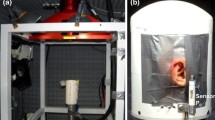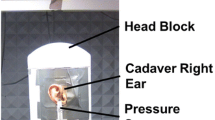Abstract
An accurate estimation of tympanic membrane stiffness is important for realistic modelling of middle ear mechanics. Tympanic membrane stiffness has been investigated extensively under either quasi-static or dynamic loading conditions. It is known that biological tissues are sensitive to strain rate. Therefore, in this work, the mechanical behaviour of the tympanic membrane was studied under both quasi-static and dynamic loading conditions. Experiments were performed on the pars tensa of four gerbil tympanic membranes. A custom-built indentation apparatus was used to perform in situ tissue indentations and testing was done applying both quasi-static and dynamic sinusoidal indentations up to 8.2 Hz. The unloaded shape of the tympanic membrane was measured and used to create specimen-specific finite element models to simulate the experiments. The frequency dependent Young’s modulus of each specimen was then estimated by an inverse analysis in which the error between experimental and simulated indentation data was optimised for each indentation frequency separately. Using an 8 μm central region thickness, we found Young’s moduli between 71 and 106 MPa (n = 4) at 0.2 Hz indentation frequency. A standard linear viscoelastic model and a viscoelastic model with a continuous relaxation spectrum were used to derive a complex modulus in the frequency domain. Due to experimental limitations, the indentation frequency upper limit was 8.2 Hz. The average relative modulus increase in this domain was 14% and the increase was the strongest below 6 Hz.
Similar content being viewed by others
References
Aernouts J, Dirckx JJJ (2011) Elastic characterization of the gerbil pars flaccida from in situ inflation experiments. Biomech Model Mechanobiol 10: 727–741
Aernouts J, Couckuyt I, Crombecq K, Dirckx JJJ (2010) Elastic characterization of membranes with a complex shape using point indentation measurements and inverse modelling. Int J Eng Sci 48: 599–611
Aernouts J, Soons JAM, Dirckx JJJ (2010) Quantification of tympanic membrane elasticity parameters from in situ point indentation measurements: validation and preliminary study. Hear Res 263: 177–182
Békésy G (1960) Experiments in hearing. McGraw-Hill, Toronto
Buytaert J, Dirckx J (2010) Phase-shifting moire topography using optical demodulation on liquid crystal matrices. Opt Lasers Eng 48: 172–181
Cai H, Jackson R, Steele C, Puria S (2010) A biological gear in the human middle ear. In: Proceedings of the COMSOL conference 2010, Boston
Cheng JT, Aarnisalo AA, Harrington E, Hernandez-Montes MDS, Furlong C, Merchant SN, Rosowski JJ (2010) Motion of the surface of the human tympanic membrane measured with stroboscopic holography. Hear Res 263(1–2): 66–77
Cheng T, Dai C, Gan R (2007) Viscoelastic properties of human tympanic membrane. Ann Biomed Eng 35: 305–314
Daphalapurkar NP, Dai C, Gan RZ, Lu H (2009) Characterization of the linearly viscoelastic behavior of human tympanic membrane by nanoindentation. J Mech Behav Biomed Mater 2: 82–92
Decraemer W, Funnell W (2008) Chronic otitis media. Pathogenesis-oriented therapeutic management, Kugler Publications, The Hague, Amsterdam, The Netherlands, chap Anatomical and mechanical properties of the tympanic membrane, pp 51–84
Decraemer W, Maes M, Vanhuyse V, Vanpeperstraete P (1980) A non-linear viscoelastic constitutive equation for soft biological tissues, based upon a structural model. J Biomech 13: 559–564
Decraemer WF, Maes MA, Vanhuyse VJ (1980) An elastic stress-strain relation for soft biological tissues based on a structural model. J Biomech 13(6): 463–468
Dirckx JJ, Decraemer WF (1992) Area change and volume displacement of the human tympanic membrane under static pressure. Hear Res 62(1): 99–104
Dirckx JJ, Decraemer WF (2001) Effect of middle ear components on eardrum quasi-static deformation. Hear Res 157(1–2): 124–137
Elkhouri N, Liu H, Funnell W (2006) Low-frequency finite-element modelling of the gerbil middle ear. J Assoc Res Otolaryngol 7: 399–411
Fay J, Puria S, Decraemer W, Steele C (2005) Three approaches for estimating the elastic modulus of the tympanic membrane. J Biomech 38: 1807–1815
Fay JP, Puria S, Steele CR (2006) The discordant eardrum. PNAS 103: 19,743–19,748
Findley WN, Lai JS, Onaron K (1976) Creep and relaxation of nonlinear viscoelastic materials. North-Holland, New York
Fung Y (1981) Biomechanics: mechanical properties of living tissues. Springer, New York
Gan R, Sun Q, Feng B, Wood M (2006) Acoustic-structural coupled finite element analysis for sound transmission in human ear—pressure distributions. Med Eng Phys 28: 395–404
Gorissen D, Crombecq K, Couckuyt I, Demeester P, Dhaene T (2010) A surrogate modeling and adaptive sampling toolbox for computer based design. J Mach Learn Res 11: 2051–2055
Hesabgar SM, Marshall H, Agrawal SK, Samani A, Ladak HM (2010) Measuring the quasi-static young’s modulus of the eardrum using an indentation technique. Hear Res 263(1-2): 168–176
Kirikae I (1960) The structure and function of the middle ear. University of Tokyo Press, Tokyo
Kuypers L, Decraemer W, Dirckx J (2005) Thickness distribution of fresh and preserved human eardrums measured with confocal microscopy. Otol Neurotol 27: 256–264
Kuypers LC, Dirckx JJJ, Decraemer WF, Timmermans JP (2005) Thickness of the gerbil tympanic membrane measured with confocal microscopy. Hear Res 209(1–2): 42–52
Ladak HM, Decraemer WF, Dirckx JJJ, Funnell WRJ (2004) Response of the cat eardrum to static pressures: mobile versus immobile malleus. J Acous Soc Am 116(5): 3008–3021
Lim DJ (1968) Tympanic membrane. Electron microscopic observation. Part i: pars tensa. Acta Oto-Laryngol 66(3): 181–198
Luo H, Dai C, Gan RZ, Lu H (2009) Measurement of young’s modulus of human tympanic membrane at high strain rates. J Biomech Eng 131:064,501–1.8
Neubert HKP (1963) A simple model representing internal damping in solid materials. Aeronaut Q 14: 187–210
Rosowski JJ, Ravicz ME, Teoh SW, Flandermeyer D (1999) Measurements of middle-ear function in the mongolian gerbil, a specialized mammalian ear. Audiol Neuro-Otol 4(3–4): 129–136
Tonndorf J, Khanna SM (1972) Tympanic-membrane vibrations in human cadaver ears studied by time-averaged holography. J Acoust Soc Am 52(4): 1221–1233
Zhang W, Chen HY, Kassab GS (2007) A rate-insensitive linear viscoelastic model for soft tissues. Biomaterials 28(24): 3579–3586
Author information
Authors and Affiliations
Corresponding author
Rights and permissions
About this article
Cite this article
Aernouts, J., Dirckx, J.J.J. Static versus dynamic gerbil tympanic membrane elasticity: derivation of the complex modulus. Biomech Model Mechanobiol 11, 829–840 (2012). https://doi.org/10.1007/s10237-011-0355-6
Received:
Accepted:
Published:
Issue Date:
DOI: https://doi.org/10.1007/s10237-011-0355-6




